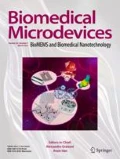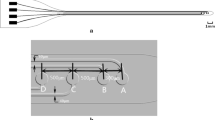Abstract
A new parylene-based microfabrication process is presented for neural recording and drug delivery applications. We introduce a large design space for electrode placement and structural flexibility with a six mask process. By using chemical mechanical polishing, electrode sites may be created top-side, back-side, or on the edge of the device having three exposed sides. Added surface area was achieved on the exposed edge through electroplating. Poly(3,4-ethylenedioxythiophene) (PEDOT) modified edge electrodes having an 85-μm2 footprint resulted in an impedance of 200 kΩ at 1 kHz. Edge electrodes were able to successfully record single unit activity in acute animal studies. A finite element model of planar and edge electrodes relative to neuron position reveals that edge electrodes should be beneficial for increasing the volume of tissue being sampled in recording applications.







Similar content being viewed by others
References
M.R. Abidian, D.C. Martin, Experimental and theoretical characterization of implantable neural microelectrodes modified with conducting polymer nanotubes. Biomaterials 29(9), 1273–1283 (2008)
D.J. Anderson, K.G. Oweiss, et al. (2001). Sensor arrays in the micro-environment of the brain. Acoustics, Speech, and Signal Processing, 2001. Proceedings. (ICASSP '01). 2001 IEEE International Conference on Salt Lake City, UT, USA
G. Buzsaki, Large-scale recording of neuronal ensembles. Nat. Neurosci. 7(5), 446–451 (2004)
H.-Y. Chen, A.A. McClelland et al., Solventless adhesive bonding using reactive polymer coatings. Anal. Chem. 80(11), 4119–4124 (2008)
K.C. Cheung, Implantable microscale neural interfaces. Biomed. Microdevices 9(6), 923–938 (2007)
C.-C. Chiang, M.-C. Chen et al., Physical and barrier properties of plasma-enhanced chemical vapor deposited -SiC:H films from trimethylsilane and tetramethylsilane. Jpn J. Appl. Phys. 1 Regular Pap. Short Notes Rev. Pap. 42(Compendex), 4273–4277 (2003)
S.F. Cogan, Neural stimulation and recording electrodes. Annu. Rev. Biomed. Eng. 10, 275–309 (2008)
S.F. Cogan, D.J. Edell et al., Plasma-enhanced chemical vapor deposited silicon carbide as an implantable dielectric coating. J. Biomed. Mater. Res. A 67(Compendex), 856–867 (2003)
X. Cui, D.C. Martin, Electrochemical deposition and characterization of poly(3, 4-ethylenedioxythiophene) on neural microelectrode arrays. Sens. Actuators, B B89(1–2), 92–102 (2003)
J.P. Donoghue, A. Nurmikko et al., Assistive technology and robotic control using motor cortex ensemble-based neural interface systems in humans with tetraplegia. J. Physiol. 579(Pt 3), 603–611 (2007)
W.F. Gorham, A New General Synthetic Method for Preparation of Linear Poly-P-Xylylenes. J. Polym. Sci. Part 1 Polym. Chem. 4(12PA), 3027-& (1966)
H. Haug, Brain sizes, surfaces, and neuronal sizes of the cortex cerebri: a stereological investigation of man and his variability and a comparison with some mammals (primates, whales, marsupials, insectivores, and one elephant). Am. J. Anat. 180(2), 126–142 (1987)
K. Hyoung-Gyun, A. Yoo-Min et al., Effect of chemicals and slurry particles on chemical mechanical polishing of polyimide. Jpn. J. Appl. Phys., Part 1 (Regular Papers, Short Notes & Review Papers) 39(Copyright 2000, IEE), 1085–1090 (2000)
X. Jun, Y. Xing et al., Surface micromachined leakage proof Parylene check valve (IEEE, Piscataway, 2001)
S. Kim, R. Bhandari et al., Integrated wireless neural interface based on the Utah electrode array. Biomed Microdevices (2008)
D.R. Kipke, W. Shain et al., Advanced neurotechnologies for chronic neural interfaces: new horizons and clinical opportunities. J. Neurosci. 28(46), 11830–11838 (2008)
D. Klee, N. Weiss et al., Vapor-Based Polymerization of Functionalized [2.2]Paracyclophanes: A Unique Approach Towards Surface-Engineered Microenvironments. Modern Cyclophane Chemistry. (Weinheim, Wiley-VCH, 2004): p.463
J. Lahann, D. Klee et al., Chemical vapour deposition polymerization of substituted [2.2]paracyclophanes. Macromol. Rapid Commun. 19(9), 441–445 (1998)
E.R. Lewis, Using electronic circuits to model simple neuroelectric interactions. Proc. IEEE 56(6), 931–949 (1968)
J.S. Lewis, M.S. Weaver, Thin-film permeation-barrier technology for flexible organic light-emitting devices. IEEE J. Sel. Top. Quantum Electron. 10(Copyright 2004, IEE), 45-57 (2004)
W. Li, D. Rodger et al., Integrated Flexible Ocular Coil for Power and Data Transfer in Retinal Prostheses. Conf Proc IEEE Eng Med Biol Soc 1(1), 1028–1031 (2005)
G.E. Loeb, M.J. Bak et al., Parylene as a Chronically Stable, Reproducible Microelectrode Insulator. IEEE Trans. Biomed. Eng. 24(2), 121–128 (1977)
N.K. Logothetis, C. Kayser et al., In vivo measurement of cortical impedance spectrum in monkeys: implications for signal propagation. Neuron 55(5), 809–823 (2007)
K.A. Ludwig, R. Miriani et al. Employing a Common Average Reference to Improve Cortical Neuron Recordings from Microelectrode Arrays. J. Neurophysiol. (2008)
K.A. Ludwig, J.D. Uram et al., Chronic neural recordings using silicon microelectrode arrays electrochemically deposited with a poly(3, 4-ethylenedioxythiophene) (PEDOT) film. J. Neural Eng. 3(1), 59–70 (2006)
J.U. Meyer, T. Stieglitz et al., High density interconnects and flexible hybrid assemblies for active biomedical implants. IEEE Trans. Adv. Packag. 24(3), 366–374 (2001)
M.A. Moffitt, C.C. McIntyre, Model-based analysis of cortical recording with silicon microelectrodes. Clin. Neurophysiol. 116(9), 2240–2250 (2005)
H. Nandivada, H.Y. Chen et al., Vapor-based synthesis of poly [(4-formyl-p-xylylene)-co-(p-xylylene)] and its use for biomimetic surface modifications. Macromol. Rapid Commun. 26(22), 1794–1799 (2005)
D.P. Papageorgiou, S.E. Shore et al., A shuttered neural probe with on-chip flowmeters for chronic in vivo drug delivery. J. Microelectromechanical Syst. 15(4), 1025–1033 (2006)
E. Pierstorff, R. Lam et al., Nanoscale architectural tuning of parylene patch devices to control therapeutic release rates. Nanotechnology 19(44), 445104 (2008)
N. Pornsin-Sirirak, M. Liger et al., Flexible parylene-valved skin for adaptive flow control (IEEE, Piscataway, 2002)
E. Purcell, J. Seymour et al. In vivo evaluation of a neural stem cell-seeded probe. Journal of Neural Engineering (In Press) (2009)
R. Rafaela Fernanda Carvalhal, F. Sanches, T.K. Lauro, Polycrystalline Gold Electrodes: A Comparative Study of Pretreatment Procedures Used for Cleaning and Thiol Self-Assembly Monolayer Formation. Electroanalysis 17(14), 1251–1259 (2005)
R. Redd, M.A. Spak et al. Lithographic process for high-resolution metal lift-off, SPIE (1999)
J. Riera, T. Ogawa et al., Concurrent observations of astrocytic Ca(2+) activity and multisite extracellular potentials from an intact cerebral cortex. J Biophotonics (2009)
E.M. Robinson, R. Lam et al., Localized therapeutic release via an amine-functionalized poly-p-xylene microfilm device. J. Phys. Chem. B 112(37), 11451–11455 (2008)
D.C. Rodger, Y.C. Tai, Microelectronic packaging for retinal prostheses. IEEE Eng. Med. Biol. Mag. 24(5), 52–57 (2005)
J.P. Seymour, Y.M. Elkasabi et al., The insulation performance of reactive parylene films in implantable electronic devices. Biomaterials 30(31), 6158–6167 (2009)
J.P. Seymour, D.R. Kipke, Neural probe design for reduced tissue encapsulation in CNS. Biomaterials 28(25), 3594–3607 (2007)
A.K. Sharma, H. Yasuda, Effect of glow discharge treatment of substrates on parylene-substrate adhesion. J. Vacuum Sci. Technol. 21(4), 994–998 (1982)
N.F. Sheppard, D.R. Day et al., Microdielectrometry. Sensors Actuators 2(3), 263–274 (1982)
A.J. Spence, K.B. Neeves et al., Flexible multielectrodes can resolve multiple muscles in an insect appendage. J. Neurosci. Meth. 159(1), 116–124 (2007)
W.C. Stacey, B. Litt, Technology insight: neuroengineering and epilepsy-designing devices for seizure control. Nat. Clin. Pract. Neurol. 4(4), 190–201 (2008)
S. Takeuchi, D. Ziegler et al., Parylene flexible neural probes integrated with microfluidic channels. Lab Chip 5(5), 519–523 (2005)
E.P.M. van Westing, G.M. Ferrari et al., Determination of coating performance using electrochemical impedance spectroscopy. Electrochim. Acta 39(7), 899–910 (1994)
R.J. Vetter, J.C. Williams et al., Chronic neural recording using silicon-substrate microelectrode arrays implanted in cerebral cortex. IEEE Trans. Biomed. Eng. 51(6), 896–904 (2004)
M.S. Weaver, L.A. Michalski et al. Organic light-emitting devices with extended operating lifetimes on plastic substrates. Appl. Phys. Lett. 81(Copyright 2002, IEE), 2929-2931 (2002)
K.D. Wise, Silicon microsystems for neuroscience and neural prostheses. IEEE Eng. Med. Biol. Mag. 24(5), 22–29 (2005)
K.D. Wise, A.M. Sodagar et al., Microelectrodes, microelectronics, and implantable neural microsystems. Proc. IEEE 96(7), 1184–1202 (2008)
D.S. Wuu, W.C. Lo et al., Plasma-deposited silicon oxide barrier films on polyethersulfone substrates: temperature and thickness effects. Surf. Coat. Technol. 197(Copyright 2006, IEE), 253-259 (2005)
G.R. Yang, Y.P. Zhao et al., Chemical-mechanical polishing of parylene N and benzocyclobutene films. J. Electrochem. Soc. 144(9), 3249–3255 (1997)
Y. Yang, S. Basu et al., Fabrication of well-defined PLGA scaffolds using novel microembossing and carbon dioxide bonding. Biomaterials 26(15), 2585–2594 (2005)
H. Yasuda, B.H. Chun et al., Interface-engineered parylene C coating for corrosion protection of cold-rolled steel. Corrosion 52(3), 169–176 (1996)
H. Yasuda, Q.S. Yu et al., Interfacial factors in corrosion protection: an EIS study of model systems. Prog. Org. Coat. 41(4), 273–279 (2001)
J. Zeng, A. Aigner et al., Poly(vinyl alcohol) nanofibers by electrospinning as a protein delivery system and the retardation of enzyme release by additional polymer coatings. Biomacromolecules 6(3), 1484–1488 (2005)
Acknowledgements
We are grateful to Prof. Joerg Lahann and Dr. Yaseen Elkasabi for providing the reactive parylene dimer and for conducting the CVD polymerization in their laboratory. Ning Gulari provided the critical idea of using CMP in this process and other helpful conversations. Drs. Pilar Herrera-Fierro, Hung-Chin Guthrie, and Ramin Emami shared their considerable CMP expertise which was vitally important. Dr. Kip Ludwig shared his method and software for automatic neural spike sorting. Dr. Mohammad Abidian and Eugene Daneshvar engaged in many helpful discussions regarding conductive polymers. We gratefully acknowledge support from the NIH P41 Center for Neural Communication Technology (EB002030) through the NIBIB.
Author information
Authors and Affiliations
Corresponding author
Electronic supplementary material
Below is the link to the electronic supplementary material.
Supplemental Fig. 1
Electric potential slices and geometries from a three-dimensional COMSOL 4.0a model for each combination of neuron position and electrode type. Electric potential (V) shown in xy-plane cutting through the electrode. (a) Planar electrode. (b) Thin edge electrode, 0.5 μm thick. (c) Thick edge electrode, 5.0 μm thick. (JPEG 423 kb)
Rights and permissions
About this article
Cite this article
Seymour, J.P., Langhals, N.B., Anderson, D.J. et al. Novel multi-sided, microelectrode arrays for implantable neural applications. Biomed Microdevices 13, 441–451 (2011). https://doi.org/10.1007/s10544-011-9512-z
Published:
Issue Date:
DOI: https://doi.org/10.1007/s10544-011-9512-z




